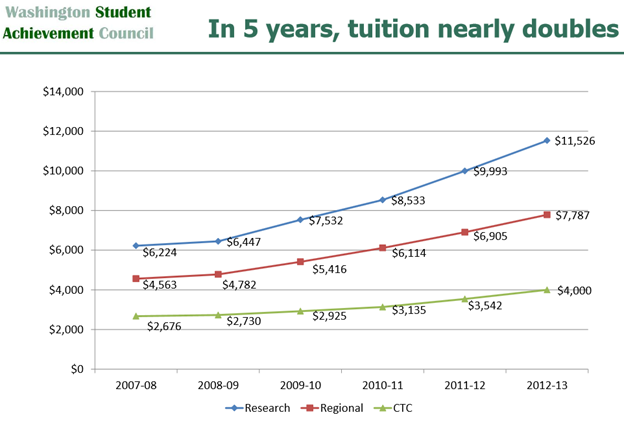College tuition prices will no doubt be a hot topic for the 2014 session. Just in the last five years, the cost of attending a public college or university in Washington has nearly doubled.

So what’s with the increase? Is it more expensive to run a school these days?
Not really. In fact, just like all other government agencies during the recession, higher education institutions have found ways to become leaner and more efficient.
College is more expensive for students today because state investments in higher education have dropped off dramatically.
Students are paying a higher portion of the costs to attend college. In 2007, a UW undergrad paid about 35% of the costs. The state paid the other 65%.
Today those numbers are reversed. Students pick up about 66% of the costs at UW while state investments have dropped to about 34%.

Thankfully, that trend has slowed and may be reversing. During the 2013 session, not only did the Legislature put an end to the cuts, but we increased investments in higher education and student financial aid.
As we look ahead, fully funding K-12 education and providing quality early learning opportunities for all children should be our top priorities in this state. But investments in higher education must also be in that same conversation when we talk about government priorities.
Higher education is the fuel that will get our economic engine surging again. A recent article from the Washington Post illustrates the connection between college degrees and higher wages:
Legislators looking for the best returns on budget investments should focus their efforts on education spending, which in turn leads to higher productivity and higher wages, according to a new report released Thursday morning.
The report, composed for the Economic Analysis and Research Network at the Economic Policy Institute, a liberal-leaning think tank, shows a strong correlation between a well-educated workforce, higher productivity and higher wages. States where higher percentages of the workforce have attained bachelor’s degrees, like Massachusetts, Connecticut, Maryland and New Jersey, have much higher average hourly wages than states with fewer college graduates, like Nevada, Arkansas, Louisiana and Mississippi, the study shows.
Click here for the full article.
